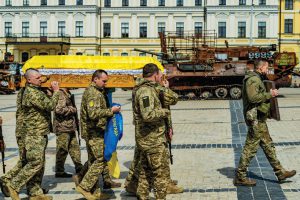BLOOMBERG
Armed with well over $30 billion in weapons freshly supplied by its allies, Ukraine is gearing up for a counteroffensive that may push Russia closer to ending its war, or show neither side has enough firepower to seize the advantage.
Kyiv’s troops will leverage that hardware — shipments delivered since December that cost more than any North Atlantic Treaty Organization (Nato) member except the US buys in a year — to try to overrun dug-in Russian positions and retake occupied territory. The question is whether it’s enough.
A dramatic breakthrough similar to Ukraine’s Kharkiv offensive in 2022 could help bring an early end to an invasion that’s disrupted energy and grain markets, fueling cost-of-living crises across the globe.
Yet this time the critical element of surprise could prove harder to achieve against a larger and better prepared Russian military. And to succeed, Ukraine will need to execute a complex so-called combined arms operation, without the advantage of air superiority, for which few militaries in the world have the necessary training.
That means coordinating infantry, armour, combat engineers and air defense to maximise the impact of the more than 200 tanks, 300 infantry fighting vehicles and other weapons Ukraine has received since December.
Ukrainian commanders have played down expectations and repeated calls for more weapons, including air defenses and long-range missiles.
For Ukraine, what happens next will depend on factors that go far beyond equipment to include training, intelligence, and whether it can continue to block Russia’s superior air force, according to military analysts.
If Ukraine can achieve only marginal gains, like those Russian forces eked out around the eastern Donbas town of Bakhmut, it may lead to another winter stalemate and rising pressure on Kyiv to give up on retaking seized territory in a ceasefire deal. In public at least, Ukraine’s allies are betting on a breakthrough.
Ukrainian land force commander Colonel-General Oleksandr Syrskyi said in Telegram post that Russian units had retreated up to 1.2 miles in areas around fiercely contested eastern town of Bakhmut. The Russian setback, if confirmed, would undo weeks of incremental gains by the semi-official Wagner units made at a high cost to life.
Norway donated four bridge-laying tanks in February. The US sent two further packages this month alone. On May 3 it agreed to send another $300 million worth of arms, including more demolition munitions, trucks, trailers and diagnostics equipment for repairs, as well as howitzers and HIMARS rockets. A $1.2 billion package announced will include critical supplies of 155 mm artillery shells and anti-aircraft missiles.
The main targets of a counteroffensive are likely to be in the south, however. To cut through layered Russian defenses will for sure take the specialist engineering equipment for clearing land mines, bridging trenches and demolishing bunkers that allies have sent. So too the hundreds of trucks and transporters needed to move heavy armour into position faster than Russia can respond.
With an estimated 700,000 soldiers in uniform, Ukraine has armed three new brigades with premium Nato tanks, as well as Bradley and other infantry fighting vehicles, Gustaf Gressel, an ex-Austrian Defense Ministry officer and now senior policy fellow with the Brussels Based European Council on Foreign Relations, said. Six more of the units, which are about 5,000 soldiers strong, are armed with Soviet-era equipment donated from Nato’s former Warsaw Pact members to replace losses from a year of fighting.
 The Gulf Time Newspaper One of the finest business newspapers in the UAE brought to you by our professional writers and editors.
The Gulf Time Newspaper One of the finest business newspapers in the UAE brought to you by our professional writers and editors.
